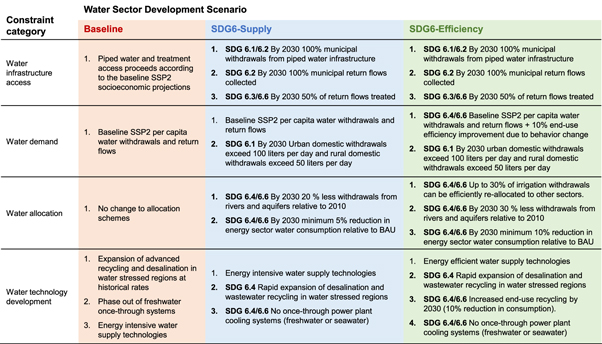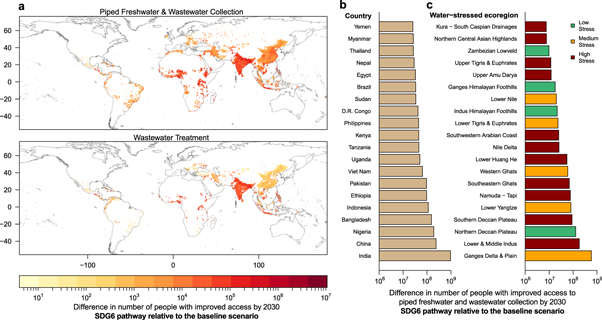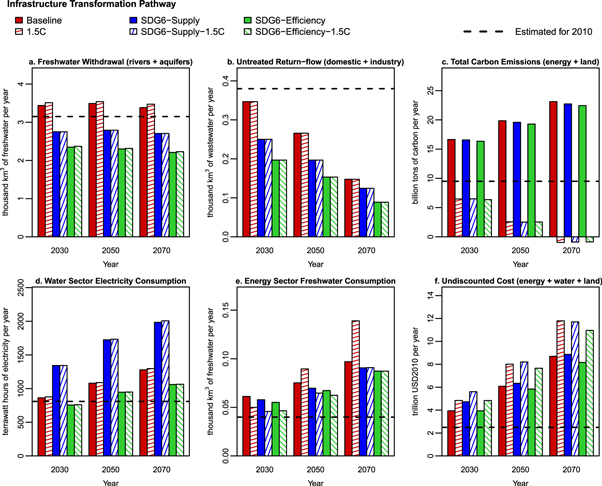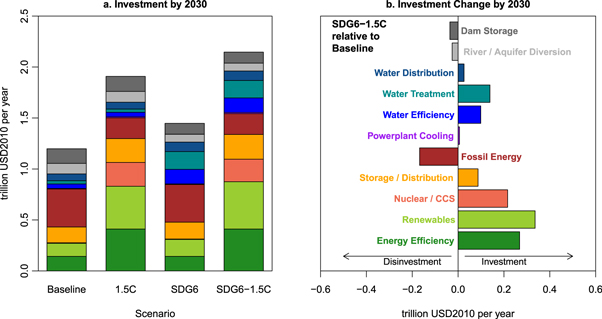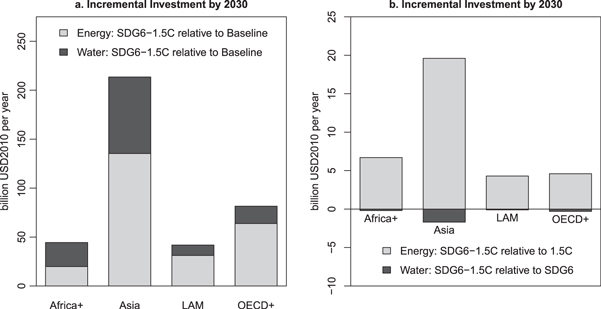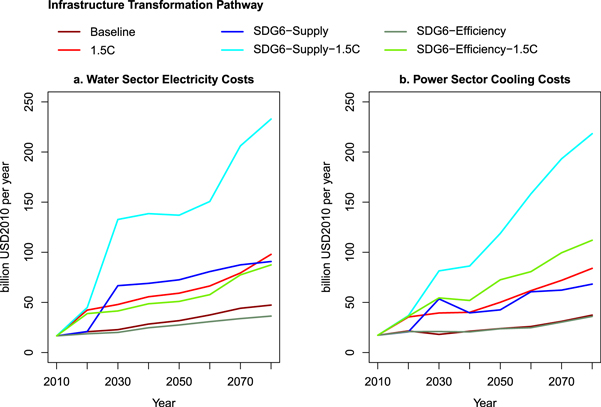Abstract
Energy systems support technical solutions fulfilling the United Nations' Sustainable Development Goal for clean water and sanitation (SDG6), with implications for future energy demands and greenhouse gas emissions. The energy sector is also a large consumer of water, making water efficiency targets ingrained in SDG6 important constraints for long-term energy planning. Here, we apply a global integrated assessment model to quantify the cost and characteristics of infrastructure pathways balancing SDG6 targets for water access, scarcity, treatment and efficiency with long-term energy transformations limiting climate warming to 1.5 °C. Under a mid-range human development scenario, we find that approximately 1 trillion USD2010 per year is required to close water infrastructure gaps and operate water systems consistent with achieving SDG6 goals by 2030. Adding a 1.5 °C climate policy constraint increases these costs by up to 8%. In the reverse direction, when the SDG6 targets are added on top of the 1.5 °C policy constraint, the cost to transform and operate energy systems increases 2%–9% relative to a baseline 1.5 °C scenario that does not achieve the SDG6 targets by 2030. Cost increases in the SDG6 pathways are due to expanded use of energy-intensive water treatment and costs associated with water conservation measures in power generation, municipal, manufacturing and agricultural sectors. Combined global spending (capital and operational expenditures) to 2030 on water, energy and land systems increases 92%–125% in the integrated SDG6-1.5 °C scenarios relative to a baseline 'no policy' scenario. Evaluation of the multi-sectoral policies underscores the importance of water conservation and integrated water–energy planning for avoiding costs from interacting water, energy and climate goals.
Export citation and abstract BibTeX RIS

Original content from this work may be used under the terms of the Creative Commons Attribution 3.0 licence. Any further distribution of this work must maintain attribution to the author(s) and the title of the work, journal citation and DOI.
1. Introduction
Achieving the objectives outlined in the United Nations' Sustainable Development Goals (SDGs) is estimated to require annual incremental spending of 1.5%–2.5% of global GDP [1]. For policy-makers, the technologies and processes supplying energy and water services are of concern because the SDGs target clean water and energy for all, while 2.1 billion people still lack access to an improved water source and 1.1 billion lack access to electricity [2, 3]. Moreover, achieving the other SDGs, such as those related to health, ecosystems, and poverty, will be contingent on meeting water and energy sustainability objectives [4, 5]. At the same time, water and energy systems are closely interlinked: water plays a key role in all stages of energy supply (e.g. fuel processing and power plant operations) [6], and conversely a significant amount of energy is required to pump and treat water resources [7]. Identifying long-term infrastructure strategies that effectively balance water, energy and human development objectives in an integrated manner can assist in achieving the SDGs [8, 9].
Concurrent to the SDG agenda is the UN Framework Convention on Climate Change's landmark Paris Agreement, which has the overarching objective of limiting 21st century global mean temperature change from pre-industrial levels to well below 2 ◦C while pursuing efforts to limit the temperature increase to 1.5 ◦C. Climate action is included as an SDG (SDG13), and avoiding climate change impacts is consistent with a number of the other SDGs [10]. However, there exist potential trade-offs between deployment of certain climate change mitigation measures and solutions consistent with the SDG6 (clean water and sanitation) agenda. Specifically, wastewater treatment capacity will need to expand rapidly in many developing regions in order to provide coverage aligned with the SDG6 targets, and the associated energy footprint could place strain on regional energy systems and climate change mitigation plans [11]. Moreover, the SDG6 water scarcity and efficiency targets can create incentive to use energy-intensive wastewater recycling and desalination technologies as solutions to reduce withdrawals from conventional surface and groundwater resources [12]. At the same time implementation of bioenergy, concentrating solar, nuclear or carbon capture and storage technologies as climate change mitigation solutions may lead to increased water use if the processes are not designed for water efficiency [13–15].
Despite widespread water–energy linkages and a breadth of knowledge on how to achieve the climate and clean water targets in isolation, there is a lack of global-scale multi-sectoral analysis quantifying the relative impacts of achieving SDG6 targets on the cost and characteristics of energy pathways consistent with the Paris Agreement [16]. Previous work provides important context but focused mainly on water-constrained national energy or land-use strategies [13, 17–19]. Previous analysis of global and regional development pathways incorporating multiple sustainability perspectives did not assess water access and treatment costs or interactions between SDG6 and climate change mitigation policies [6, 20–25]. The lack of consistent policy treatment across water and energy systems at the global-scale limits our understanding of the investments needed to achieve the SDGs.
Here, we assess integrated water-energy-land systems transformation to begin to unravel the costs and characteristics of global pathways consistent with both the Paris Agreement and SDG6 objectives. The MESSAGEix-GLOBIOM integrated assessment model (IAM), used previously to develop globally comprehensive energy and land pathways consistent with deep decarbonization [26], is enhanced in this work to include a reduced-form, regionally-specific representation of the global water sector. The new approach represents an improvement in IAM analysis because it accounts for future shifts in global water use patterns driven by a combination of socioeconomic changes and SDGs, and links these projections and policies to water availability, and the cost, energy and emissions impacts of future infrastructure systems. The coupling of water and climate policy modeling at the global-scale supports prospective analysis of the investment burden from multiple targets occurring over different sectors, timeframes and geographic scales. The results highlight the important role of IAMs in finding low-cost global pathways consistent with multiple SDG objectives.
2. Methods
The technical implementation of the IAM and the water sector enhancements is detailed in the supplementary information (sections S1.1–S1.3, available online at: stacks.iop.org/ERL/14/014009/mmedia), with salient features of the methods used to evaluate multi-sectoral water and climate polices summarized here. The scenario for population, economic growth and other key drivers is constructed from an existing IAM representation of the middle-of-the-road Shared Socioeconomic Pathway (i.e. SSP2) [26–28]. The Paris Agreement and SDG6 policies are included in the IAM as additional constraints, and force the IAM to identify feasible least-cost implementation scenarios for the 21st century in 11 geographic regions. The countries included in each region are listed in the supplementary Information (table S1 and figure S1).
The 1.5 ◦C climate policy is implemented as a constraint on cumulative emissions over the 21st century across energy and land systems. Consistent emission budgets and pathways are derived from previous climate model simulations [26]. Additional constraints ensure energy demands are consistent with universal energy access, prevent bioenergy from being sourced from irrigated crops, and limit the carbon price of land-based mitigation measures to avoid impacts to food pricing in low-income regions [20, 29, 30].
The analysis does not cover all of the targets associated with SDG6, including those for flood management and transboundary cooperation. Two unique pathways consistent with the SDG6 narrative bridge uncertainties driven by future end-use behavior and technological development. A supply-oriented pathway (SDG6-Supply) combines the SDG6 policy implementation with business-as-usual (baseline) water use projections. The scenario primarily features expansion of supply-side technologies in response to mitigating future demand growth. An efficiency-oriented pathway (SDG6-Efficiency) features a transition towards a future where significant progress is made on the demand-side in terms of reaching sustainable water consumption behavior across all sectors. A key feature is the inclusion of irrigation conservation as an approach to meet water targets through re-allocation of saved water to other sectors.
Figure 1. The water sector development scenarios and parameterized water constraints for the analysis. Constraints specific to SDG6 are indicated in bold.
Download figure:
Standard image High-resolution imageThe SDG6 water access and quality targets (6.1–6.3) are integrated into the IAM by constraining the required capacity of water infrastructure systems. The SDG6 pathways feature a transition in 2030 to universal piped water access and wastewater collection and towards wastewater treatment capacity able to treat a minimum of half all return flows. Increasing the fraction of wastewater that is treated also protects water-related ecosystems and is consistent with SDG6 target 6.6. Access rates are projected in the baseline scenario by combining the SSP2 income projections with a logistics model fit to historical national-data (supplementary information, figure S6) [31, 32].
It is important to emphasize the parameterized constraints represent our interpretation of the SDG6 targets, and that the interpretation could be implemented differently by other analysts. Representing the diversity of possible outcomes remains a common challenge for global IAMs, and future research might address the uncertainty by eliciting and analyzing additional scenarios developed by multiple modeling teams (e.g. [33]).
In total, 3.5 billion more people require access to piped water infrastructure and wastewater collection by 2030 and 1.8 billion more people require access to wastewater treatment under the SDG6 pathway relative to the baseline scenario (figure 2(a)). This outcome stems from the projected income-levels in 2030 under the baseline SSP2 narrative, and the associated future water source and treatment access rates derived from the income-based logistics model (supplementary information, figure S6). Namely, in many low-income regions the baseline SSP2 projections do not achieve levels of water access and treatment consistent with the SDG6 targets. Some regions (e.g. Indus Basin) face multiple challenges in meeting the SDG6 objectives because of extreme existing water stress combined with a wide infrastructure gap projected for 2030 (figure 2(c)). It will be difficult for these regions to expand freshwater supply in the domestic sector without reducing demands elsewhere because of a lack of surface and groundwater resources.
Figure 2. Comparison between projected piped water access and wastewater treatment rates under the SDG6 and baseline water policy scenarios (a). Spatially-explicit (7.5 arc-min) differences between projected piped water access and water treatment levels in the SDG6 scenario relative to the baseline scenario; (b) differences in population with piped water access and wastewater collection aggregated by country [39]; and (c) differences categorized by the water-stressed ecological regions defined in Hoekstra et al [40] (supplementary information, figure S5).
Download figure:
Standard image High-resolution imageConsistent water withdrawal and return flow trajectories for the SSP2 scenario are generated to represent demands in the irrigation, municipal (domestic) and manufacturing sectors (supplementary information, section 1.3) [26, 34]. To reflect transformation towards universal access to sufficient water for human development, municipal water withdrawals in all countries in the SDG6 pathways are adjusted such that all urban areas achieve per capita demands of at least 100 l per day while rural areas achieve demands of at least 50 l per day (supplementary information, figure S7) [35–37]. Costs for water distribution and wastewater collection in the municipal and manufacturing sectors are estimated based on average cost data compiled by the World Health Organization [38], combined with the modeled withdrawal and return-flow volumes (supplementary information, section S1.3). This approach aligns closely with previous work that quantified costs to achieve universal access to clean water and sanitation [38, 41, 42], but also smooths out some of the known cost variability for distribution systems under diverse topographic conditions [43], and thus results do not provide detailed cost-level information at the municipal- or city-scale.
Expansion pathways for advanced water treatment (i.e. wastewater recycling and desalination) are incorporated into the water sector transformations to supply increasing future urban withdrawals in water stressed regions [12, 44, 45], which is in line with SDG6 target 6.4 (substantially reduce the number of people suffering from water scarcity). Diffusion is limited based on two criteria: (i) the historical 5 year maximum regional growth rate calculated using an asset-level global desalination database [44]; and (ii) a logistics model that limits expansion in low-income regions (supplementary information, section S1.3). Wastewater recycling is prioritized over seawater desalination to reflect additional environmental challenges typically associated with desalination (e.g. brine production, marine thermal pollution, etc). A maximum recycling rate of 80% of the urban return flow is assumed to reflect difficulties in capturing and recycling all wastewater to potable standards [46]. Wastewater recycling can also take various forms, including direct application of domestic wastewater for uses that do not require potable quality [46]. To assess impacts on the results we incorporate a transition towards low-cost, energy-efficient recycling systems in the SDG6-Efficiency scenario using performance data identified in the literature (supplementary information, table S3) [47, 48].
We define conservation cost curves for additional end-use water conservation measures in the municipal, manufacturing and agricultural sectors. Significant diversity in conservation measures exists across regions, and a full assessment of the opportunities and implementation costs is beyond the scope of this paper. We alternatively applied a stylized approach to include expected conservation costs and impacts at the regional-scale. Previous work quantified the impact of various conservation options and associated implementation costs, and generally show that conservation costs increase nonlinearly and offset a limited fraction of water demand [49–52]. We assume a general form for the conservation curve that enables consistent linearization across regions (supplementary information, figure S8). A maximum conservation potential in each sector representing 30% of the baseline withdrawals is assumed in this paper, and is a somewhat conservative interpretation of previous assessments that focus specifically on water conservation potentials for specific sectors [49, 50, 52, 53]. We use 0.3 USD10 per m3 to represent the average cost for conservation measures because this approximates the point at which it can be expected that investment switches to expanding yield from conventional raw surface and groundwater sources [54].
Water efficiency measures aligned with SDG6 target 6.4 are also embedded into the SDG6 energy transformation pathways. Energy sector water consumption post-2030 is limited to a fixed percentage of the estimated freshwater consumption in the baseline scenario without climate policy (5% less in the SDG6-Supply scenario and 10% less in the SDG6-Efficiency scenario). This pushes the energy sector in each region to improve water consumption intensity through transformational changes in the energy supply-chain. Furthermore, once-through cooling systems are phased-out completely in the SDG6 scenarios to avoid thermal water pollution [55], helping to protect water-related ecosystems in line with SDG6 target 6.6. The baseline scenario also maintains trends away from freshwater once-though systems and towards recirculating (closed-loop) systems [56, 57], but does not feature a specific consumption reduction target or constraints on seawater once-through systems. The manufacturing sector is also assumed to implement water conservation measures more aggressively in the SDG6-Efficiency pathways, achieving lower average national water intensities than in the SDG6-Supply pathways. The withdrawal and return flow trajectories for each region including the impacts of conservation are presented in the supplementary information (figures S8–S12).
3. Results
3.1. Integrated solution pathways
Select global indicator pathways calculated with the enhanced IAM under the water and climate policy scenarios are depicted in figure 3. In both SDG6 scenarios, global freshwater withdrawals from rivers and aquifers and untreated return flows decrease relative to the estimated 2010 volumes (figure 3(a)). In the SDG6-Efficiency scenario, 26% less freshwater is withdrawn from rivers and aquifers and 43% less wastewater is returned to the environment untreated by 2030 relative to volumes estimated for 2010. These savings could improve environmental flows while reducing water pollution.
Figure 3. Impacts of combined water and climate policies on select global indicator pathways (2010–2070): (a) freshwater withdrawals from rivers and aquifers across irrigation, municipal and industrial sectors; (b) untreated return-flows from the municipal and industrial sectors; (c) total carbon emissions across energy and land systems; (d) water sector energy consumption (electricity); (e) energy sector water consumption (excluding hydropower); and (f) undiscounted costs calculated across water and energy systems (sum of the investment, fixed and variable cost components).
Download figure:
Standard image High-resolution imageTo avoid freshwater withdrawals from conventional surface and groundwater resources while increasing the fraction of wastewater that is treated, an upscaling of efficiency, alternative freshwater sources and wastewater treatment capacity is required. In the SDG6-Supply scenario, global desalination capacity increases from 24 km3 in 2010 to 250 km3 in 2070. At the same time, advanced wastewater recycling capacity expands from an estimated 16 km3 in 2010 to 720 km3 in 2070. The expansion occurs mainly in the Middle East/North Africa and South Asia regions (supplementary information, figures S18 and S19) where extreme water stress is combined with rapidly growing urban populations. Global water sector electricity consumption (figure 3(d)) increases from 820 TWh per year in 2010 (4% of global demand) to more than 2000 TWh per year by 2070 (3%–6% of global demand), reflecting growing water consumption and the expanded use of advanced water treatment. In contrast, electricity consumption for water supply decreases in the SDG6-Efficiency scenario due to lower water demands and higher energy efficiencies assumed for the water technologies. Water efficiency investments reduce withdrawals across all sectors by approximately 30%, resulting in reduced expansion of advanced water treatment (desalination capacity reaches 70 km3 in 2070 while recycling reaches 190 km3).
Global carbon emissions in 2030 (figure 3(c)) do not vary significantly across scenarios (<2%) indicating minimal interactions between the emission pathway and the ramp-up in energy-intensive water infrastructure systems to meet the SDG timeline. Emissions in the 1.5 °C scenarios reduce rapidly and are negative in 2070 due to a combination of land-based mitigation measures and carbon capture technologies. Global energy sector water consumption (figure 3(e)) is at the same time increasing in all scenarios. Post-2030 the baseline 1.5 °C energy transformation pathway requires more water than when no climate policy is included for two reasons: (1) there are higher electricity demands from increasing end-use electrification; and (2) certain low-carbon power generation options (e.g. nuclear) have a larger water footprint than conventional combined-cycle natural gas systems prevalent in transformations under no climate policy [6]. The SDG6 scenarios feature additional water efficiency targets that achieve net reductions compared to estimated 2010 levels (5% in SDG6-Supply and 10% in SDG6-Efficiency), but the conserved water volumes are negligible when considered in the broader context of the regional volumes supporting irrigation, municipal and industrial sectors (figure 3(a)).
3.2. Impact on system costs
The undiscounted total costs representing the sum of the investment (capital) and operational expenditures for water, energy and land systems (figure 3(f)) indicate in order to achieve the clean water targets by 2030 while placing infrastructure on a path consistent with 1.5 °C that annual spending needs to be increased 92%–125% relative to the baseline scenario. Comparing results across scenarios further indicates that to 2030, similar effort is needed to move towards pathways consistent with SDG6 as with 1.5 °C, but that in the long-term, spending to achieve 1.5 °C dominate. Regional cost results isolated for water and energy systems and interpreted on a per capita basis (table 1) are 100–300 USD per year. Per capita costs are largest in high-income economies because these regions consume most on a per capita basis. Regional results further demonstrate that the costs associated with achieving both climate and clean water targets range between 0.8% and 2.5% of regional GDP, with higher fractions occurring in developing regions. The sustainable consumption narrative embedded in the SDG6-Efficiency scenario results in the long-term costs decreasing relative to the other scenarios tested (figure 3(f)), and this is due to avoided spending on supply infrastructure. It is important to emphasize that broader impacts of the SDG6-Efficiency narrative on e.g. production costs in the agriculture and manufacturing sectors are not accounted for in the presented cost estimates, which would impact the anticipated benefits of water conservation.
Table 1. Regional water and energy costs (investment plus operational) for the baseline and integrated policy scenarios. SDG6-1.5C-S represents the scenario combining the SDG6-Supply policies with the 1.5 °C emissions constraint. SDG6-1.5C-E represents the scenario combining the SDG6-Efficiency policies with the 1.5 °C emissions constraint. The presented indicators are computed as annual averages over the 2020 and 2030 model decision-making periods. Africa+ includes the countries within Sub-Saharan Africa, the Middle East and North Africa. OECD+ includes countries in North America and Western Europe, as well as countries in Eastern Europe and including Russia. LAM includes countries in Latin America. A full list of the countries considered in each region is provided in the supplementary information (table S1).
| Region | Total cost (billion USD2010 per year) | Cost per capita (USD2010 per year) | Percent GDP (%) | ||||||
|---|---|---|---|---|---|---|---|---|---|
| Baseline | SDG6-1.5C-S | SDG6-1.5C-E | Baseline | SDG6-1.5C-S | SDG6-1.5C-E | Baseline | SDG6-1.5C-S | SDG6-1.5C-E | |
| Asia | 450 | 660 | 650 | 110 | 160 | 150 | 0.9 | 1.4 | 1.4 |
| LAM | 80 | 170 | 130 | 120 | 250 | 200 | 0.8 | 1.7 | 1.3 |
| Africa+ | 180 | 270 | 220 | 110 | 160 | 130 | 1.6 | 2.5 | 2.0 |
| OECD+ | 290 | 460 | 380 | 200 | 310 | 260 | 0.6 | 1.0 | 0.8 |
Analysis of the investment portfolios (expenditures on new infrastructure capacity) by 2030 indicates re-allocation of financing away from fossil fuels and conventional freshwater supply systems combined with a massive ramp-up in investment in efficiency and clean supply projects across water and energy systems supports the multi-sectoral policy objectives (figure 4). In SDG6-1.5C scenarios, by 2030 on average more than 170 billion USD per year is disinvested in fossil fuel activities relative to the baseline scenario and used to partially fund the 910 billion USD per year in increased spending on efficiency and low-carbon resources. Compared to the 1.5 °C scenario without SDG6 targets, there is increased use of wind and solar to reduce the capacity of thermal power generation and associated water requirements (supplementary information, figures S20 and S21). In the water sector, average investments into conventional surface and groundwater systems including large-scale dams is reduced by 60 billion USD per year relative to the baseline scenario. At the same time incremental investment into piped water access and water treatment reaches 260 billion USD per year, closing the infrastructure gaps projected under baseline conditions (figure 2).
Figure 4. Global investment and investment change portfolios for achieving the SDG6 policies by 2030 while placing energy systems on a path consistent with 1.5 °C. Depicted costs for scenarios including SDG6 are averages across SDG6-Supply and SDG6-Efficiency. Dam storage represents large-scale reservoir systems used for surface water storage. River/aquifer diversion represents extractions of freshwater from surface and groundwater resources. Water distribution includes piped water supply and wastewater collection. Water treatment includes both conventional and advanced (recyling and desalination) technologies. Water efficiency measures cover irrigation, urban, rural and manufacturing sectors. Power plant cooling includes once-through (fresh and ocean water), closed-loop and air cooling technologies. Fossil energy represents all technologies that extract and convert fossil energy resources. Storage/Distribution technologies include energy grids and liquid fuel storage. Renewables includes wind, solar, geothermal and bioenergy technologies. Energy efficiency measures cover the industrial, building and transport sectors.
Download figure:
Standard image High-resolution imageIncremental water sector investment needs are found to be greatest in Asia and Africa (figure 5(a)) because these regions face a combination of rapidly growing demands and existing water stress in certain basins. Relatively little incremental water sector investment needs are projected for developed economies (North America and Europe) because these countries already have high access and treatment rates exceeding the SDG6 targets. Incremental investments in these regions are supporting efficiency and advanced water treatment, which are helping to reduce projected withdrawals from rivers and aquifers in water stressed regions. Incremental energy investment needs to achieve 1.5 °C exceed water investment needs for the SDG6 targets in each of the aggregated macro-regions, but these trends may differ when assessed at higher spatial resolutions.
Figure 5. Incremental water and energy investment costs by 2030 across global regions: (a) SDG6-1.5C relative to baseline; and (b) SDG6-1.5C relative to 1.5C for energy investments and SDG6-1.5C relative to SDG6 for water investments. Depicted costs for scenarios including SDG6 are averages across SDG6-Supply and SDG6-Efficiency. Africa+ includes the countries within Sub-Saharan Africa, the Middle East and North Africa.OECD+ includes countries in North America and Western Europe, as well as countries in Eastern Europe and including Russia. LAM includes countries in Latin America. A full list of the countries considered in each region is provided in the supplementary information (table S1).
Download figure:
Standard image High-resolution imageA comprehensive analysis of the energy investments to achieve the Paris Agreement and associated uncertainties are detailed in McCollum et al [29]. In this paper, we find that energy sector investments in 2030 increase by an estimated 35 billion USD per year when the SDG6 policies are added on top of the 1.5 °C climate policy (figure 5(b)). The incremental investments are supporting increased electricity generation capacity needed to supply water sector demands and for implementation of water-efficient power plant cooling technologies. Conversely, investments supporting the SDG6 policies display much less sensitivity when the 1.5 °C climate policy is added (figure 5(b)) because the SDG6 policies are constraining water infrastructure coverage and thus driving the observed investment levels across scenarios. Disinvestments in the water sector found when comparing the SDG6 scenarios with and without the 1.5 °C target (figure 5(b)) are attributed to reduced capacity of river/aquifer diversions and dam storage upstream from the energy sector. Specifically, when the 1.5 °C target is added, the energy system must transform rapidly, and to avoid exceeding the embedded water efficiency targets later in the time horizon and the prospect of stranded assets, the integrated SDG6-1.5C pathways feature accelerated transformation towards water-efficient energy technologies, and this results in lower energy sector water withdrawals in the near term and the avoided water sector investment costs observed in figure 5(b).
Despite limited impacts to water sector investments, the increasing energy supply costs under a 1.5 °C policy are translated to water infrastructure systems according to their energy consumption intensity, which is increasing in the SDG6 pathways in many regions due to expanded water treatment. Figure 6(a) depicts estimated future operational electricity costs in the water sector across scenarios, and indicates that combining the 1.5 °C policy with the SDG6-Supply scenario results in annual spending on electricity reaching 110 billion USD in 2030 and growing further to 160 billion USD in 2070. Conversely, spending on electricity in the water sector remains relatively steady in the SDG6-Efficiency scenario, reaching a much lower global expenditure of 110 billion USD per year by 2070. We find a similar scale of spending (investment and operational costs) will be needed to simultaneously transition power systems towards more water efficient cooling technologies (figure 5(b)), which are more expensive and less energy-efficient than conventional options and becoming increasingly expensive to operate under decarbonization.
Figure 6. Global cost impacts of the combined SDG6 and 1.5 °C policies from water–energy interactions: (a) water sector electricity costs; and (b) power sector cooling costs.
Download figure:
Standard image High-resolution image4. Discussion
The results demonstrate that balancing trade-offs between climate change mitigation and clean water policies requires a global shift in investment and operational decision-making across sectors that is best delivered through targeted policies developed from an integrated water–energy perspective. We find that implementation of the SDG6 targets for water access and wastewater treatment cause relatively minor impacts to the energy sector when compared to the effort needed for climate change mitigation. Conversely, water efficiency targets aligned with SDG6 applied to the energy sector cause changes to the long-term energy technology strategy used to mitigate climate change. Specifically, there is increased exploitation of wind and solar technologies as well as use of air cooling systems in the near-term to simultaneously reduce carbon and water intensity of electricity.
Our results further demonstrate that climate change mitigation can increase operational costs for water supply systems. Cost increases might be passed on to consumers based on future water pricing schemes or through taxes supporting government subsidies that often protect consumers from abrubt price changes reflecting the full cost of water infrastructure. Thus, targeted climate policies could include subsidies designed to protect vulnerable populations in water stressed regions, where there is the greatest risk for climate change mitigation to impact water-related costs due to a limited range of energy-intensive freshwater supply options. Major cost uncertainties relate to the scale of future water demand growth in water stressed regions and how re-allocation across sectors can address supply expansion. We find that a transition to achievable water consumption intensities combined with re-allocation of water across sectors (e.g. from irrigation to urban areas) can largely offset trade-offs between the investigated SDG6 targets and climate policy objectives.
Finding and improving synergies between decarbonization and water efficiency is therefore paramount for minimizing joint policy implementation costs and uncertainties. For example, many processes within the water sector are candidates for recruitment in electricity sector demand response programs or for integration with combined heat and power management [58, 59]. Leveraging these integrated solutions will be important for increasing efficiency and the penetration of renewable generation sources. Moreover, continuing innovation with emerging wastewater treatment processes could lead to significant reductions in energy intensity [60]. In the near term, water and energy resource planners should promote integrated valuation of efficiency measures and supply-side projects to ensure system development aligns with sustainability goals [51].
The analysis did not consider impacts of interbasin transfers, future flood management, transboundary agreements, fertilizer application or livestock waste management practices in response to water targets, which would present further constraints to the development pathways. More spatial detail is also needed to unravel within-basin impacts of upstream conservation on downstream water availability. Finally the analysis in this paper does not cast a wide enough net to capture the expected benefits of climate change mitigation in terms of the avoided impacts on water resources and consequently the performance of energy technologies that rely on water availability. Significant geographic diversity is anticipated, and impacts may be partially mitigated when aggregated across regions and globally [61, 62]. Nonetheless, avoiding adaptation costs in the 1.5 °C scenarios is expected to improve synergies with the SDG6 targets in many regions.
Despite these limitations, to our knowledge, this paper is the first to provide harmonized global pathways for water and energy infrastructure that align with elements of SDG6 and a 1.5 ◦C climate target. Future research might address additional SDG6-climate change mitigation challenges identified above by zooming into local areas to assess the multi-sector costs and benefits of policy integration [63]. In this context, it is critical to incorporate clean water-climate change mitigation interactions with other SDGs, particularly those with strong interdependencies, such as the SDGs involving targets for poverty, food, health and biodiversity.
Acknowledgments
The authors acknowledge the Global Environment Facility (GEF) for funding the development of this research as part of the Integrated Solutions for Water, Energy, and Land (ISWEL) project (GEF Contract Agreement: 6993), and the support of the United Nations Industrial Development Organization (UNIDO). The research has also been supported by the European Union's Horizon 2020 Research and Innovation Programme under grant agreement No. 642147 (CD-LINKS), the University of Victoria, and the Natural Sciences and Engineering Research Council of Canada.
Footnotes
- 10
All costs are reported in 2010 US Dollars (USD2010) to ensure consistency of the input data sources.


